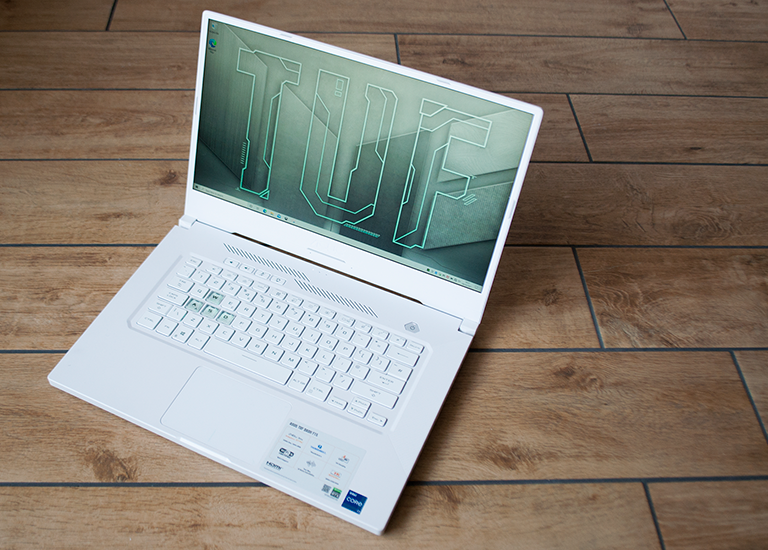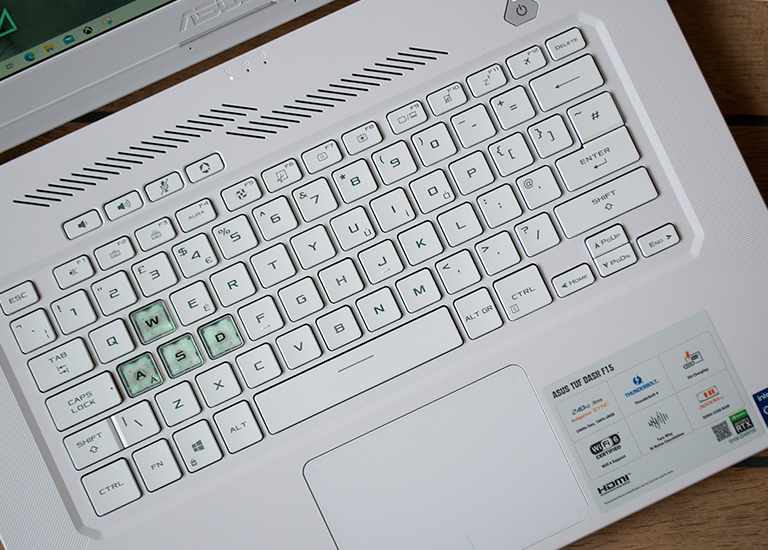Introduction
All of the industry's big names have been quick to jump on the GeForce RTX 30 Series bandwagon. In the mobile space, Nvidia's latest Ampere architecture vows to deliver "the world's fastest laptops for gamers and creators," and whether you're gearing up for school or working remotely, cutting-edge tech holds plenty of attraction.
Hoping to tempt those users seeking high-performance thrills without breaking the bank, the Asus TUF Dash F15 holds potential insofar as it features an 11th Gen Intel CPU as well as GeForce RTX 30 Series graphics at a starting price of £999.
The entry-level spec unites a Core i7-11370H processor with GeForce RTX 3060 6GB graphics, a 512GB M.2 SSD and 8GB of DDR4 memory. Stretch the budget to £1,299 and memory is increased to 16GB, while graphics are bumped up to an 8GB GeForce RTX 3070. Both specifications carry a 144Hz 1080p display as standard, but our review unit, with a top-end 240Hz panel and 1TB SSD, sadly isn't being made available on UK shores.
Still, it's an opportunity to get acquainted with the TUF Dash proposition, and to our surprise, we find ourselves quite liking Asus's striking white chassis. The laptop does also come in black for those who prefer to keep it simple, yet the stark contrast of white works well in the flesh, and overall build quality is decent if not spectacular. There's some flex to the display lid, but the base is rigid enough and the design feels reasonably well-balanced.
Build and Specifications
Asus's 15.6in display is surrounded by slim bezels on the top and sides, the tenkeyless keyboard feels spacious and airy, and we like the fact that the lid is easily opened with one hand. Dimensions of 360mm x 252mm x 19.9mm are about right for a system of this category, and though the 2kg weight isn't the easiest to lug around, TUF Dash F15 will easily slip into a backpack.
A laptop of such proportions ought to be well-stocked in the connectivity department, and Asus doesn't disappoint. In addition to an Intel Wi-Fi 6 AX201 adapter, the laptop's left side is home to a 3.5mm combination audio jack, Thunderbolt 4 Type-C, USB 3.2 Gen 1 Type-A, HDMI, Gigabit Ethernet and a connector for the bundled 200W power supply. A further two USB 3.2 Gen 1 Type-A reside on the laptop's right, while the back is reserved solely for air vents.
Bold aesthetics, 11th Gen Core i7, RTX 3070 and all the connectivity you're likely to need sounds a tasty proposition, yet the on-paper promise doesn't necessarily align with the real-world experience. Intel's 11th gen mobile parts are limited to quad-core configurations at the time of writing - the 35W quad-core i7-11370H on show here isn't a natural replacement for the 45W eight-core chips regularly featured within previous-gen gaming laptops - and as we know from earlier editorial, mobile RTX 30 Series GPUs come in a variety of configurations.
Nvidia's official specifications suggest that the RTX 3070 Laptop GPU can be configured with a TDP of between 80 and 125W, resulting in a wide boost clock range of up to 1,290MHz on lower-end parts and up to 1,620MHz on thirstier chips. With the TUF Dash F15, Asus plays it ultra-conservative by adopting an 80W configuration dialled into the lowest possible speed. There is an option to activate a Turbo mode through Armory Crate, which elevates boost clock to 1,390MHz at the expense of considerable fan noise, but as the benchmarks will illustrate, guaranteeing well in excess 60fps at 1080p isn't as easy as you might think.
User Experience
While gaming laptops typically attempt to incorporate everything but the kitchen sink, TUF Dash F15, for reasons we can't fathom, is designed without a built-in webcam. We can't remember the last time a laptop passed through the HEXUS labs absent some form of basic camera, and given the growing importance of working remotely, it is a surprise omission on an otherwise well-stocked machine.
You get the impression that Asus is a few tweaks away from delivering a capable all-rounder, as there are elements of the laptop that work well. The keyboard - backlit in an odd-but-not-unpleasant pale-green colour - benefits from the lack of numpad and is comfortable from the get go, with good travel and a quiet, cushioned sound. We could do without the transparent WASD keycaps - they look somewhat tacky in the flesh - and the dedicated Armory Crate shortcut key alongside the volume shortcuts feels unnecessary; mute or play/pause would be preferable.
Stereo speakers flanking the keyboard make up for a lack of depth through sheer volume, and the large trackpad is suitably responsive with integrated buttons that don't feel overly clicky. This is a comfortable laptop on which to game or work, though Asus could do more to minimise bloatware - McAfee LiveSafe has a tendency to nag the user on a regular basis. Right, enough build-up, who's ready for some benchmark results?












